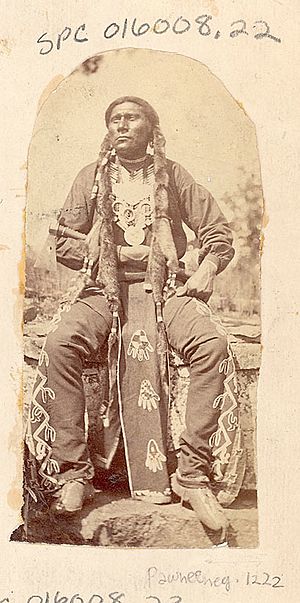Big Spotted Horse facts for kids
Big Spotted Horse was a brave Pawnee warrior and leader who lived in the 1800s. He belonged to the Pitahawirata group of the Pawnee tribe.
Contents
A Young Warrior's Brave Act
In 1852, when Big Spotted Horse was only about 15 or 16 years old, his Pawnee tribe was hunting buffalo near the Solomon River in what is now Kansas. They were suddenly attacked by other Plains tribes.
A Cheyenne warrior named Alights-on-the-Clouds chased after young Big Spotted Horse. This Cheyenne warrior wore special armor made of leather and metal discs that protected him from arrows and bullets. He wanted to perform a brave act called "counting coup" on Big Spotted Horse before harming him. Counting coup meant touching an enemy without killing them, showing great courage.
The Cheyenne warrior approached Big Spotted Horse from the right side. Usually, a right-handed person with a bow can only shoot well to their left. But Big Spotted Horse was left-handed! As the warrior got close, Big Spotted Horse quickly turned and shot an arrow right into the Cheyenne warrior's eye.
The Pawnee people cheered loudly. They soon found out that the Cheyenne warrior was wearing armor. Losing Alights-on-the-Clouds was a big blow to the Cheyenne, who then left the battle. The Pawnee celebrated this victory and even made a song to remember Big Spotted Horse's amazing deed.
Other stories say that another Pawnee warrior named Shield Chief was responsible for this brave act.
The Great Horse Raid
As Big Spotted Horse grew up, he became a respected warrior and was very skilled at taking horses from other tribes. In 1869, he led a small group of Pawnee warriors to a Cheyenne village near the Arkansas River.
They bravely entered the village itself and untied the best horses that were tied to the lodges. Then, they gathered the rest of the herd, taking about 600 horses in total! They started their journey home, even though it was winter and a big snowstorm hit them. The raiders suffered from frostbite, but they managed to bring the entire herd back to the Pawnee village.
Taking horses from other tribes was a common practice among Native American groups. It showed bravery and brought wealth to the tribe. However, the Pawnee's Indian agent, Jacob M. Troth, did not approve. When he saw 600 new horses, he knew something had happened.
The agent called Big Spotted Horse to explain. When the agent called him a "big horse thief," Big Spotted Horse thought it was a compliment, meaning he was a "great horse thief"! The interpreter quickly explained that the agent was not happy. The agent demanded that the horses be returned to the Cheyenne. Big Spotted Horse refused, knowing how the Cheyenne would react.
He was put in prison at Fort Omaha for five months. But he was eventually released because there was no actual law against taking horses from other tribes at that time. When he returned to the Pawnee village, most of the horses were gone. Only about 30 or 40 were left, and those had already been returned to the Cheyenne. Disappointed, Big Spotted Horse left to join the Wichita tribe in Oklahoma.
Scouting for the U.S. Army
Big Spotted Horse also served as a scout for the U.S. Army. An officer named Richard Henry Pratt described him as "a tall, fine specimen of man who enjoyed dangerous service." While living in Oklahoma, Big Spotted Horse helped the army as a scout during the Red River War in 1874.
Joining the Wichita Tribe
Big Spotted Horse had become friends with the Wichita people before his big horse raid. The Wichita tribe was closely related to the Pawnee, but they had moved south earlier.
In 1872, Big Spotted Horse returned to the Pawnee village. He and other warriors began to suggest that the whole Pawnee tribe should move to live with the Wichita, who had invited them. However, the Pawnee chiefs did not agree with this idea.
Around that time, white settlers were stealing wood from the Pawnee reservation. In late 1873, the Indian Agent Jacob Troth asked a group of Pawnee, including Big Spotted Horse, to stop these wood thieves.
In 1874, Big Spotted Horse left the reservation with about 300 followers. Then, in 1875, the entire Pawnee tribe, even though their chiefs were against it, decided to join them. They left their good lands in Nebraska for poorer lands in Oklahoma.
Big Spotted Horse's Last Journey
Big Spotted Horse never returned from his last horse raid into Texas.


